Menus
- Not just for beginners
- Kawasaki Ninja 300-Twin loves speed
- KTM RC 390 as light as a feather and jagged
- Fully fueled KTM 164 kilos, stately 177 for the Ninja 300
- The rear-heavy Kawasaki remains rock solid
- ABS brakes and consumption
- Simple but functional versus cheeky and unconventional
- Data and measured values
- Performance measurement
- MOTORCYCLE scoring
- MOTORCYCLE test results
- Used Kawasaki Ninja 300 and KTM RC390 in Germany
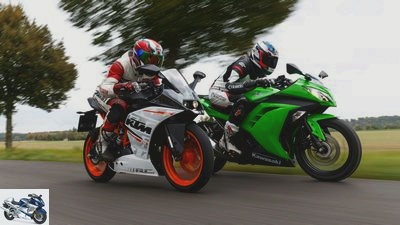
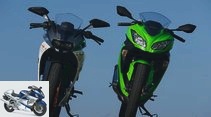


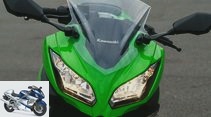
31 photos

1/31
KTM RC 390.
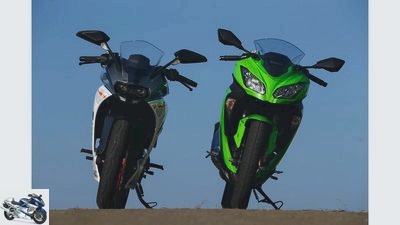
2/31
Comparison test Kawasaki Ninja 300 and KTM RC 390.
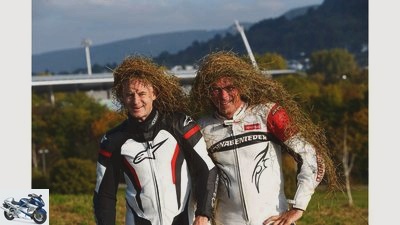
3/31
Comparison test Kawasaki Ninja 300 and KTM RC 390.
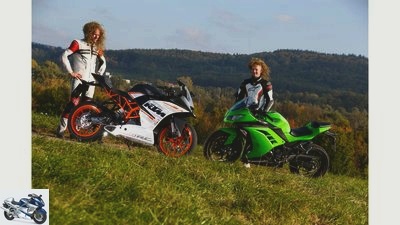
4/31
Comparison test Kawasaki Ninja 300 and KTM RC 390.
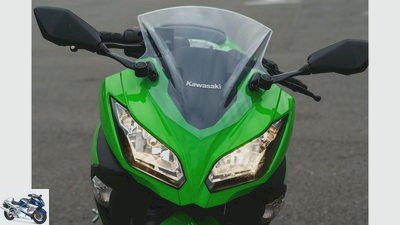
5/31
Kawasaki Ninja 300.
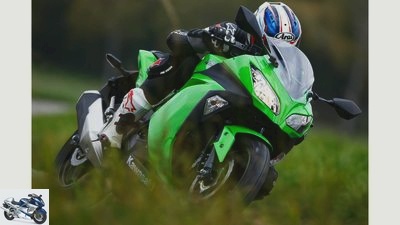
6/31
Kawasaki Ninja 300.
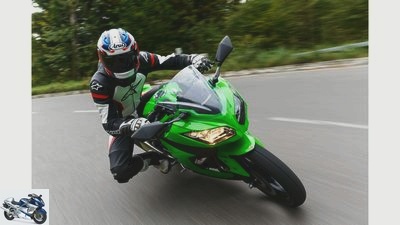
7/31
Kawasaki Ninja 300.
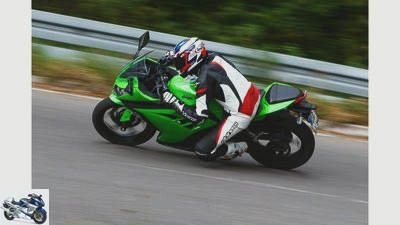
8/31
Kawasaki Ninja 300.

9/31
Kawasaki Ninja 300.

10/31
Kawasaki Ninja 300.
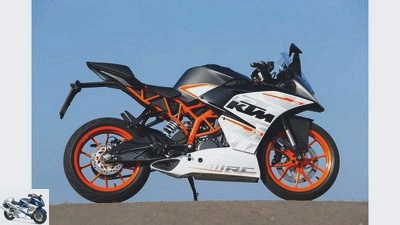
11/31
KTM RC 390.
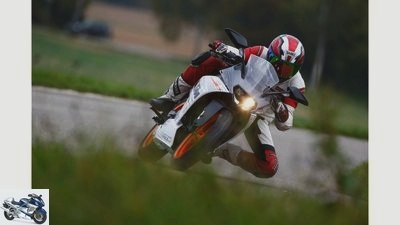
12/31
KTM RC 390.
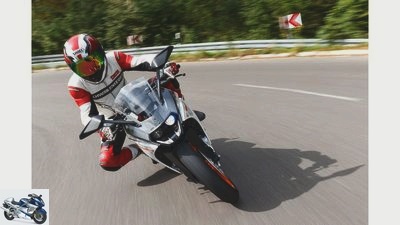
13/31
KTM RC 390.
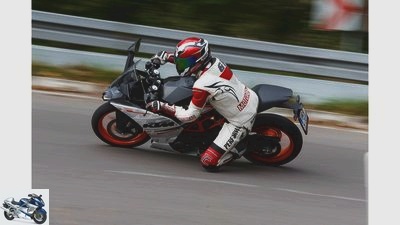
14/31
KTM RC 390.
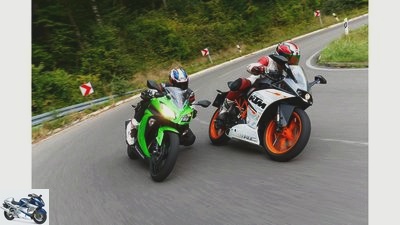
15/31
Comparison test Kawasaki Ninja 300 and KTM RC 390.
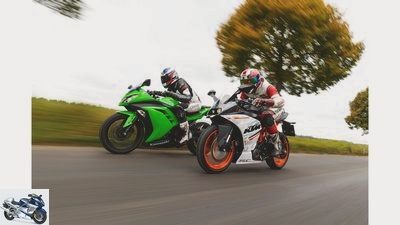
16/31
Comparison test Kawasaki Ninja 300 and KTM RC 390.

17/31
Comparison test Kawasaki Ninja 300 and KTM RC 390.
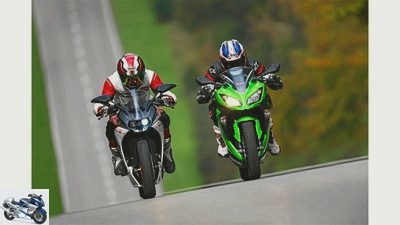
18/31
Kawasaki Ninja 300 and KTM RC 390: So what can the entry-level racers do? Definitely a grown-up appearance.
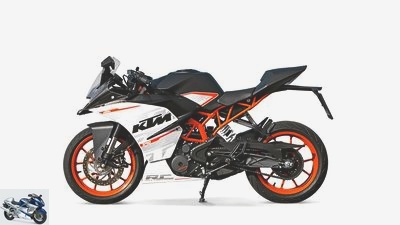
19/31
KTM RC 390: Aggressive and unmistakably KTM thanks to the orange tubular space frame and angular design.
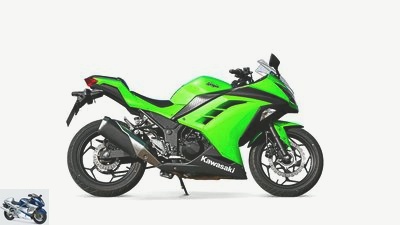
20/31
Kawasaki Ninja 300: The smallest ninja takes optical borrowings from the bigger Kawasaki athletes.
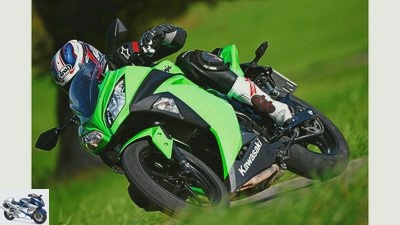
21/31
Kawasaki Ninja 300.
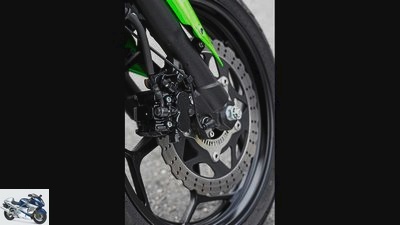
22/31
The simple two-piston floating caliper in the front wheel does its job quite well, but with a better brake pump it would be capable of even more.
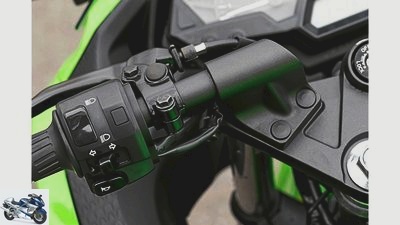
23/31
The high-mounted handlebar halves ensure comfortable upright sitting.
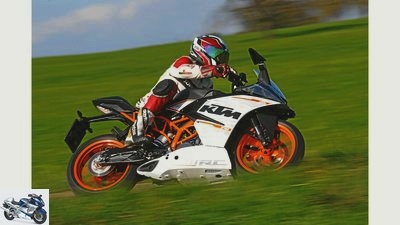
24/31
KTM RC 390.
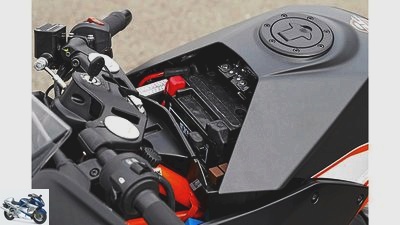
25/31
The battery sits under a fiddly to assemble cover behind the steering head, which puts weight on the front wheel.

26/31
Handlebar tubes are stored directly in the upper triple clamp, which can be expensive in the event of a fall.
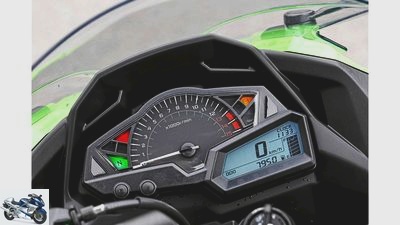
27/31
Kawasaki Ninja 300: Conventionally designed cockpit with little information and an easy-to-read analog tachometer.
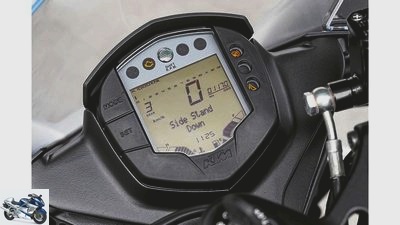
28/31
KTM RC 390: shift light, on-board computer, gear and engine temperature display, everything is there. The tachometer is difficult to read.
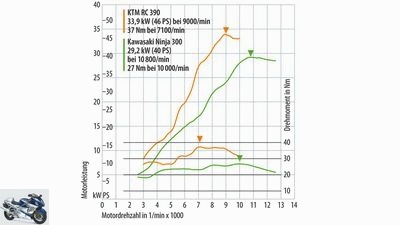
29/31
Power on the crankshaft. Measurements on the Dynojet roller test stand 250, corrected according to 95/1 / EG, maximum possible deviation ± 5%.
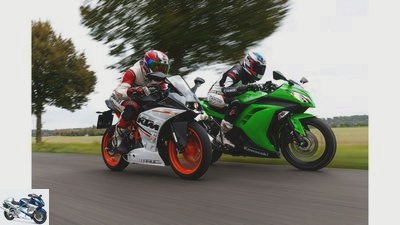
30/31
Comparison test Kawasaki Ninja 300 and KTM RC 390.
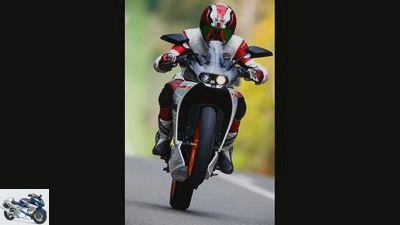
31/31
KTM RC 390.
Kawasaki Ninja 300 and KTM RC 390 in comparison test
Not just for beginners
The Kawasaki Ninja 300 is already very popular. It is now facing competition from the KTM RC 390. Low weight and sufficient power promise unadulterated driving pleasure – not just for beginners.
If you want to amaze your buddies at the regulars’ table, you should simply ask them which KTM is probably the best-selling this year. No, it is neither the Adventure nor the Super Duke R. The KTM 390 Duke barely tops the hit list, but at least it tops the charts. With the brand’s sporty appearance, it made sense to build a street sports offshoot with the famous 390 single-cylinder. Especially since the little runners are slowly but surely enjoying increasing popularity. So it went Kawasaki Ninja 300 so far twice as often over the counter as the ZX-10R and ZX-6R combined. Bright spots in the starving super sports segment. So what can the entry-level racers do??
Buy complete article
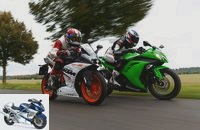
Kawasaki Ninja 300 and KTM RC 390 in comparison test
Not just for beginners
Ninja 300 is like the face of its big sister, the ZX-6R. The angular KTM RC 390 comes with grim-looking headlights and is optically self-confidently based on its big sister RC8 R with its orange tubular frame. It’s a matter of honor that both are suitable for beginners with an A2 driver’s license. The Kawasaki, for this story from the Filderstadt dealer Limbacher & Limbacher provided, starts with a revving twin, which fires its nominal 39 hp at 11,000 rpm. One cylinder less, but 77 cm³ and 5 hp more, throws the KTM into the balance. As in the Duke, its single cylinder delivers 44 hp at 9500 rpm. While the Kawasaki starts working without any problems, the starter of the KTM RC 390 has to turn the organ for a few seconds before the single crashes into life.
Kawasaki Ninja 300-Twin loves speed
The clutch on the Kawasaki Ninja 300 is easy to pull and first gear gently engages. Right from the start, the twin flatters the driver with its fine running culture. It does not pull out trees below 5000 rpm, but it purrs obediently, runs smoothly from 2000 rpm and hangs cleanly on the gas. As soon as the pointer of the analog rev counter has passed five, the counter-rotor comes to life and turns into the five-digit range without complaint. Its march through the rev range is largely free of annoying vibrations and without being indecently loud. In higher registers, its sonorous sound only gets a snotty, cheeky, pithy note. At 11,000 rpm, a full 40 hp are on hand.
Push in the next gear and go on. The twin of the Kawasaki Ninja 300 loves revs, no question about it, but thanks to its fine running smoothness and the wide, usable rev range, it can also purr very relaxed across the country. The shift work is a pleasure with the smooth clutch and buttery gear changes.
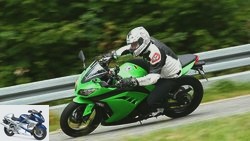
motorcycles
Driving report: Kawasaki Ninja 300
More bite: the new Kawasaki Ninja 300 in the test
read more
All tests and articles about the Kawasaki Ninja 300
KTM RC 390 as light as a feather and jagged
Nevertheless, the driver of the Kawasaki Ninja 300 has to give it a try if he wants to follow the KTM RC 390. Your single cylinder grabs with a stronger handshake when starting off and pushes forward with vigor. You can feel the higher torque from the first meter. The single cylinder too, however. With a robust punch, he announces his single existence and happily shoots out of the underfloor exhaust. The KTM reacts a little more directly to gas commands than the Kawa, but takes it a bit harder. The stew is a hearty fellow, vibrations are of course there, but never take on a disruptive level. However, the speed should not fall below 3000 rpm, otherwise he protests with rattling concentricity. At 5000 rpm, the vibrations and a little vigor ebb away. Nevertheless, it delivers more power than the Kawa-Twin over the entire speed range. And from this mark on there is real tinder, the single hammers away with verve. His revving peaks in a remarkable 46 hp at 9000 rpm. This corresponds to a liter output of a good 123 hp. For an approved single cylinder the hammer. Shortly before the red area, the shift light flickering in the cockpit calls for the next gear in the crisp six-speed gearbox, whoever continues to turn is caught shortly afterwards by the hard limiter.
The Kawasaki Ninja 300 has a hard time following on winding little roads, no matter how hard it is squeezed. The KTM RC 390 of course benefits from its significantly shorter gear ratio. At around 170 km / h it runs into the limiter. At this speed, the Kawa performance and driving resistance are also in balance. But there is still a good 600 revolutions of air left to the red area. But it’s not just because of the engine that it has to stretch a lot to keep up. If the Kawa is wonderfully handy, the KTM goes a step further. How light as a feather and jagged, almost weightlessly, it can be bent is a stunner.
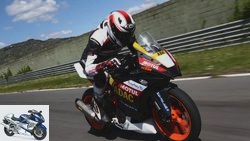
Super athlete
KTM RC 390 Cup in the driving report
Fountain of youth for MOTORCYCLE testers
read more
Fully fueled KTM 164 kilos, stately 177 for the Ninja 300
The chassis geometry of the KTM RC 390, with a steep steering head angle (66.5 degrees), short wheelbase (1340 mm) and ultra-short caster (88 mm), is significantly faster than that of the Kawasaki Ninja 300 with a moderate 63 degrees, 93 mm caster and a full six and a half centimeters longer wheelbase (1405 mm). Your pilot sits relaxed, lower, in the middle of the vehicle. This arrangement may even be a bit too compact for tall people.
In addition, the green in the knee area is significantly wider than the wonderfully narrow KTM. The pilot sits higher, more oriented towards the front wheel, bent lower. And this is exactly how the KTM RC 390 sticks into the corners: greedy, precise, almost thirsty for deep lean angles. The handling of the Kawasaki Ninja 300, on the other hand, is less agitated, more forgiving, but also not with this crisp precision. While the KTM statically rests 54 percent of the weight on the front wheel, the Kawa is just under 49. With the rider, the Kawasaki becomes significantly more rear-heavy, while the weight distribution of the KTM is practically balanced at almost 50/50. Speaking of weight: the scales show a slim 164 kilos for the fully fueled KTM, stately 177 for the Kawa.
The rear-heavy Kawasaki remains rock solid
But back to cornering. There, the shock absorber of the Kawasaki Ninja 300, which is overdamped in the rebound stage, hails the tight line at the exit of the curve, on which the KTM RC 390 dashes provocatively and precisely out of the curve. The suspension comfort of the Kawasaki shock absorber – although it has a deflector – is quite manageable. In return, its simple telescopic fork is responsive and conscientiously takes care of both small and coarse bumps, and it is sufficiently tight.
The upside-down fork of the KTM RC 390 is not quite as sensitive, but it is also sufficiently tight. The directly hinged shock absorber of the RC 390 with its unusually long 150 mm suspension travel is, on the other hand, extremely softly cushioned and lets the KTM teeter through fast, undulating curves without the orange looking wobbly, unstable or nervous. In addition, the Metzeler Sportec Interact M5 are a safe bet when sharpening bends, as they offer more reserves in terms of feedback and grip, especially in the wet, than the IRC Road Winners with which the Kawasaki Ninja 300 is soled.
ABS brakes and consumption
In tricky situations, both pilots can rely on ABS support when they apply the brakes. The radial pliers on the front wheel of the KTM RC 390 grips spontaneously and can be easily dosed, but then requires firm grip in order to slow down heavily. The Kawasaki Ninja 300 has a long free travel on the hand lever that hardly allows two-finger braking. Once this has been overcome, the two-piston floating caliper grips very firmly. Both deliver a decent delay. The Kawasaki comes to a stop from 100 km / h after 42 meters and thus even two meters in front of the KTM, despite the much coarser ABS regulation. The KTM’s anti-lock device regulates much more precisely and quickly. But when compressed, it becomes restless faster, does a front wheel dance on the last few meters, the downside of the sporty design with a short wheelbase and a lot of front wheel load. The longer, more rear-heavy Kawasaki, on the other hand, remains rock solid and on the ground and thanks to the slipper clutch, it stays on track. No more corner robbers. The KTM reports low tide in the tank and reminds you to go to the pump. There is almost a tie there. The KTM 3.2 liters is tame, the Ninja just a tenth more. What can become 4.7 (KTM) or 5.3 liters (Kawasaki) when doing research.
Simple but functional versus cheeky and unconventional
While the fuel gurgles into the tanks, there is some time to take a closer look at the two of them. The Kawasaki Ninja 300 looks pleasing, its sports sisters cut the face, really grown up. The KTM RC 390, on the other hand, is bold and crisp, unconventional, and not just because of the angular design. Stable upside-down fork, radial brake, underfloor exhaust and cast aluminum swing arm in half-timbered look with beautiful chain tensioners, that makes a difference. The tubular space frame anyway.
The Kawasaki Ninja 300 with telescopic fork and steel swing arm, on the other hand, is comparatively objective, simple but functional. Like the cockpit with an analog tachometer, but otherwise stingy with information. Not even a temperature display is on board. And you will look in vain for things like on-board computers or even gearshift lights like the KTM. On the other hand, your LCD tachometer can only be read moderately. A smart detail of the KTM RC 390: the solo hump is the pillion seat because it is made of foam, not hard plastic.
The tanks are full, the KTM tank holds a measly ten liters, which at least gives it a range of 313 kilometers. The Ninja 300, on the other hand, shines with touring-friendly 17 liters and a huge 515 km radius of action, plus it offers slightly better light and more visibility in the rear-view mirrors and thus keeps an eye on everyday life a little more than the KTM, which shines as a lively arsonist and fun maker plays.
Data and measured values
engine
| Kawasaki Ninja 300 |
KTM RC 390 |
|
| design type | Two-cylinder four-stroke- In-line engine |
Single cylinder four-stroke engine |
| injection | 2 x Ø 32 mm | 1 x Ø 46 mm |
| coupling | Multi-disc oil bath- clutch (anti-hopping) |
Multi-panes- Oil bath clutch |
| Bore x stroke | 62.0 x 49.0 mm | 89.0 x 60.0 mm |
| Displacement | 296 cc | 373 cc |
| compression | 10.6: 1 | 12.5: 1 |
| power | 29.0 kW (39 hp) at 11,000 rpm |
32.0 kW (44 PS) at 9500 rpm |
| Torque | 27 Nm at 10,000 rpm | 35 Nm at 7250 rpm |
landing gear
| Kawasaki Ninja 300 | KTM RC 390 | |
| frame | Bridge frame made of steel | Steel tubular frame |
| fork | Telescopic fork, Ø 37 mm |
Upside-down fork, Ø 43 mm |
| Brakes front / rear | Ø 290/220 mm | Ø 300/230 mm |
| Assistance systems | SECTION | SECTION |
| bikes | 2.75 x 17; 4.00 x 17 | 3.00 x 17; 4.00 x 17 |
| tires | 110/70 ZR 17; 140/70 ZR 17 | 110/70 ZR 17; 150/60 ZR 17 |
| Tires | IRC Road Winner RX 01 | Metzeler Sportec M5 Interact |
Dimensions + weight
| Kawasaki Ninja 300 | KTM RC 390 | |
| wheelbase | 1405 mm | 1340 mm |
| Steering head angle | 63.0 degrees | 66.5 degrees |
| trailing | 93 mm | 88 mm |
| Front / rear suspension travel | 120/130 mm | 125/150 mm |
| Seat height¹ | 770 mm | 820 mm |
| Weight with a full tank¹ | 177 kg | 164 kg |
| Payload¹ | 177 kg | 171 kg |
| Tank capacity / reserve | 17.0 / – liters | 10.0 / 1.5 liters |
| Service intervals | 6000 km | 5000 km |
| price | 5595 euros | 5595 euros |
| Additional costs | 180 euros | 200 euros |
MOTORCYCLE readings
| Kawasaki Ninja 300 | KTM RC 390 | |
| Top speed | 170 (170 *) km / h | 172 (160 *) km / h |
| acceleration | ||
| 0-100 km / h | 6.1 sec | 5.5 sec |
| 0-140 km / h | 13.8 sec | 11.4 sec |
| Draft | ||
| 60-100 km / h | 7.7 sec | 7.3 sec |
| 100-140 km / h | 9.7 sec | 7.4 sec |
| Consumption country road / 100 km | 3.3 liters | 3.2 liters |
| Reach country road | 515 km | 313 km |
* Manufacturer information; ¹MOTORWHEEL measurements
Performance measurement
Power on the crankshaft. Measurements on the Dynojet roller test stand 250, corrected according to 95/1 / EC, maximum possible deviation ± 5%.
The KTM single surpasses the Kawasaki two-cylinder in practically every speed range. The single already offers below
around a lot of torque and really comes to life from 5000 rpm. The twin also loves high speeds, but can also be moved just over 2000 rpm. Both engines reach their maximum output well before the red zone and thus offer plenty of over-rev reserves.
MOTORCYCLE scoring
engine
| Maximum score |
Kawasaki Ninja 300 | KTM RC 390 | |
| Draft | 40 | 5 | 8th |
| acceleration | 40 | 5 | 8th |
| Top speed | 30th | 7th | 7 * |
| Engine characteristics | 30th | 13 | 15th |
| Responsiveness | 20th | 12th | 13 |
| Load change | 20th | 12th | 11 |
| Smoothness | 20th | 13 | 10 |
| coupling | 10 | 8th | 8th |
| circuit | 20th | 13 | 12th |
| Gear ratio | 10 | 8th | 9 |
| Start | 10 | 8th | 7th |
| total | 250 | 104 | 108 |
The Kawa-Twin runs extremely cultivated, has a wide usable speed range in addition to a smooth transmission. In addition, it starts more spontaneously and offers a smooth-running anti-hopping clutch. But he only plays second fiddle to the robust, much stronger and easy-turning KTM single.
Winner engine: KTM RC 390
landing gear
| maximum number of points | Kawasaki Ninja 300 | KTM RC 390 | |
| Handiness | 40 | 35 | 37 |
| Stability in turns | 40 | 23 | 25th |
| Steering behavior | 40 | 25th | 28 |
| feedback | 10 | 7th | 8th |
| Inclined position | 20th | 15th | 17th |
| Straight-line stability | 20th | 18th | 18th |
| Suspension tuning in front | 20th | 11 | 11 |
| Chassis set-up at the rear | 20th | 9 | 11 |
| Adjustment options undercarriage | 10 | 1 | 1 |
| Suspension comfort | 10 | 5 | 6th |
| Driving behavior with a passenger | 20th | 9 | 10 |
| total | 250 | 158 | 172 |
A clear thing for the KTM RC 390. It is more agile, more direct and more precise. Even if it is very soft at the back. The overdamped shock absorber of the Kawasaki Ninja 300 is reflected in the steering precision and the suspension comfort. But their clean, attractive telescopic fork is pleasing. Both get along well with a passenger.
Chassis winner: KTM RC 390
everyday life
| maximum number of points | Kawasaki Ninja 300 | KTM RC 390 | |
| Ergonomics driver | 40 | 22nd | 24 |
| Ergonomics pillion | 20th | 4th | 5 |
| Windbreak | 20th | 4th | 4th |
| view | 20th | 9 | 8th |
| light | 20th | 14th | 14th |
| Furnishing | 30th | 7th | 12th |
| Handling / maintenance | 30th | 20th | 20th |
| Luggage storage | 10 | 2 | 1 |
| Payload | 10 | 3 | 3 |
| Range | 30th | 30th | 18th |
| processing | 20th | 11 | 12th |
| total | 250 | 126 | 121 |
If you like it sporty, even tall people will find a comfortable place on the KTM RC 390. The cockpit provides extensive information on this. The Kawasaki shows more traffic and fewer driver arms in the rear-view mirrors, scores above all with its colossal range.
Everyday Winner: Kawasaki Ninja 300
security
| maximum number of points | Kawasaki Ninja 300 | KTM RC 390 | |
| Braking effect | 40 | 22nd | 20th |
| Brake metering | 30th | 20th | 21st |
| Braking with a passenger / fading | 20th | 11 | 10 |
| Righting moment when braking | 10 | 9 | 9 |
| ABS function | 20th | 11 | 12th |
| Handlebar slapping | 20th | 20th | 20th |
| Ground clearance | 10 | 8th | 7th |
| total | 150 | 101 | 99 |
Both shine with a decent delay. With slight advantages for the ninja, whose brake loses points in terms of controllability due to the long free travel on the lever.
Safety winner: Kawasaki Ninja 300
costs
| maximum number of points | Kawasaki Ninja 300 | KTM RC 390 | |
| guarantee | 30th | 15th | 17th |
| Consumption (country road) | 30th | 28 | 28 |
| Inspection costs | 20th | 12th | 9 |
| Maintenance costs | 20th | 18th | 18th |
| total | 100 | 73 | 72 |
Stalemate in consumption and maintenance costs. 6000 intervals (KTM: 5000) and shorter guide times at Kawa.
Winner Cost: Kawasaki Ninja 300
| maximum number of points |
Kawasaki Ninja 300 |
KTM RC 390 |
|
| Overall rating |
1000 | 562 | 572 |
| placement | 2. | 1. | |
| Price-performance note | 1.0 | 1.7 | 1.6 |
Price-performance winner: KTM RC 390
With practically the same price, this rating is just about the sportier KTM RC 390.
MOTORCYCLE test results
1. KTM RC 390
More maneuverable chassis, powerful, lively and economical engine, many nice details. In addition, at the same price level as the Kawasaki. These are the ingredients thanks to which the KTM wins.
2. Kawasaki Ninja 300
Engine revs easily and cultivated, handling and seating position relaxed and relaxed, huge range, low inspection costs. These are the kawasaki’s trump cards. But the shock absorber and low pulling power cost points.
Used Kawasaki Ninja 300 and KTM RC390 in Germany
1000PS marketplace app
Used KTMs are much more common on the used market.
The KTM RC 390 not only wins the comparison but also wins the used market. It quickly becomes clear that the Ninja 300 is nowhere near as popular as the super sports car from Mattighofen, if you look at the number of used Kawas. You can find the price differences here: used Kawasaki Ninja 300 and KTM RC 390 in Germany.
Related articles
-
Kawasaki Z 800 in the top test
j.kuenstle.de 15 pictures 1/15 The Kawasaki Z 800 is the successor to the Z 750 and in the MOTORRAD top test. 2/15 Wheelie with the …
-
Comparison test BMW S 1000 RR, Kawasaki ZX-10R and Yamaha YZF-R1M
22 images 1/22 BMW S 1000 RR, Kawasaki Ninja ZX-10R and Yamaha YZF-R1M. 2/22 Yamaha YZF-R1M. 3/22 BMW …
-
Comparison test sports tourer Kawasaki Z 1000 SX Tourer, Triumph Sprint GT
www. 35 pictures www. 1/35 Sports tourers sit between all chairs, but the temptation lies in this niche: there are bikes, …
-
Comparison test Honda CBR 250 R against Kawasaki Ninja 250 R
fact comparison test: Honda CBR 250 R against Kawasaki Ninja 250 R 250 super sports car for beginners Content of Honda’s CBR 250 R and the Kawasaki Ninja 250 …
-
BMW F 800 R, Kawasaki Z 800, MV Agusta Brutale 800 and Yamaha FZ8 in the test
Jahn 29 photos Jahn 1/29 A comparison of four 800 class motorcycles: BMW F 800 R, Kawasaki Z 800, MV Agusta Brutale 800 and Yamaha FZ8. Jahn 2/29 Like…
-
Kawasaki Ninja ZX-10R – old versus new compared
fact 24 pictures www.factstudio.de 1/24 Kawasaki ZX-10R: old versus new. www.factstudio.de 2/24 Kawasaki ZX-10R 2016: Brembo instead of Tokico, “balance free” …
-
Comparison test Honda CBR 500 R, Kawasaki Ninja 400, KTM RC 390, Yamaha YZF-R3
r-photography.info 29 pictures r-photography.info 1/29 Honda CBR 500 R, Kawasaki Ninja 400, KTM RC 390 and Yamaha YZF-R3 in comparison test ….
-
Motocross Comparison Test – Honda, Kawasaki, KTM, Suzuki and Yamaha
Jahn 16 pictures Jahn 1/16 Kawasaki KX 450 F, KTM 350 SX-F, Yamaha YZ 450 F, KTM 450 SX-F, Suzuki RM-Z 450 and Honda CRF 450 R in the large MX1 (450cm³) …
-
Ducati 1299 Panigale S and Kawasaki Ninja H2 in comparison test
31 pictures 1/31 Left in the picture 197 HP and 145 Nm (Ducati 1299 Panigale S), on the right there are 200 HP and 133 Nm (Kawasaki Ninja H2) ….
-
BMW F 800 GT, Kawasaki Z 1000 SX and Honda VFR 800 F in the test
fact 44 photos fact 1/44 fact 2/44 fact 3/44 fact 4/44 fact 5/44 In praise of diversity: the three test candidates all want the same thing, but try to…